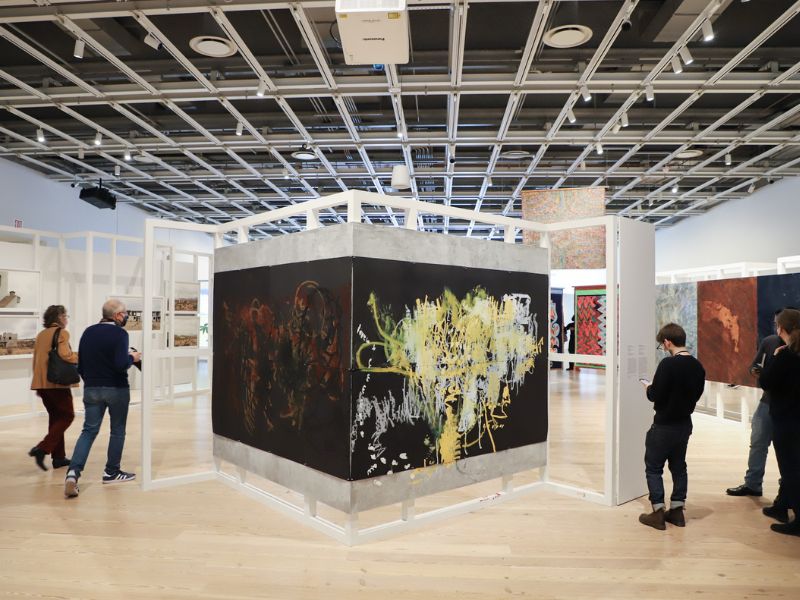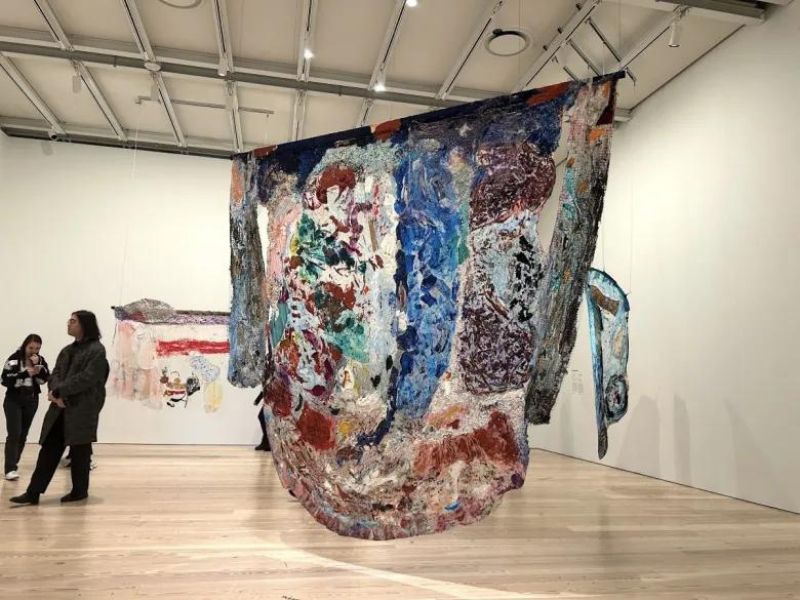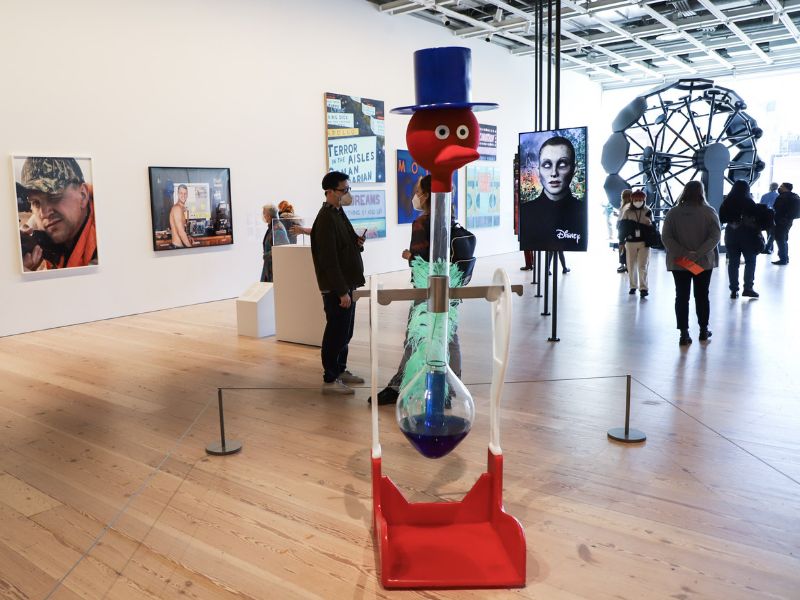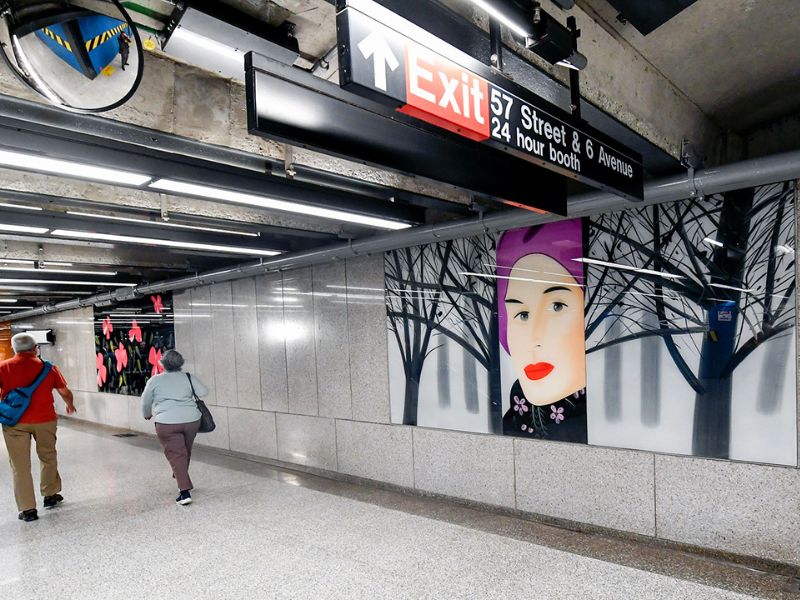Summer within the metro framework is hot, but it’s around to urge a parcel cooler—the Whitney Exhibition Hall of American Craftsmanship is bringing large-scale works of art to certain stations around NYC.
Celebrating its Biennial, the Whitney joined up with the MTA to put up vinyl establishments of works of art by previous and current Biennial artists—including Roy Lichtenstein, Jane Dickson, Dawoud Bey, Alex Katz, and Eamon Ore-Giron—on the exteriors of previous retail spaces on three tram station stages: West Fourth Road, Jay Road, and Fordham Street.

Nearby this tram takeover, the Whitney has moreover made a computerized outline where you’ll see the Biennial’s history, which ranges from 1932 and “then and now” photographs from the ’30s and current day, counting a comparison of Biennial craftsman Jane Dickson’s 1983 work “Dobbs Hats” to nowadays in Times Square.
To celebrate, the MTA and the Whitney are facilitating craftsmanship ventures in tram stations and other social education adjacent open transportation all summer long, beginning at Union Square station on June 1. From 10:30 am to 2 pm or until supplies are final, Whitney teachers will walk individuals through an extent motivated by craftsman Ruth Asawa (who was in three Whitney Biennials) to beautify Whitney tote bags with natural products and vegetables.
Other dates include (the Whitney Museum Biennial 2024):
- June 29 at the New York Botanical Gardens (an institution accessible by subway and Metro-North that inspired Whitney Biennial artist Joseph Stella)
- July 27 at the New York Transit Museum
- Later this summer (TBA) at the Hudson Yards subway station
The 2024 Whitney Biennial starts and closes with summons of rot. Exhibited on paint-spattered plastic tarps attached to the dividers and floor of the campaign exhibition are enigmatically human arrays built from debris that Ser Serpas collects from the boulevards around her Brooklyn neighborhood: An upturned shopping cart and a disco ball embellish a vertically standing workout seat; a fire hydrant leans back on a corroded utility cart; a yoga ball is dubiously suspended inside a battered metal platform.

Wedged in one corner, a sectional situate with uncovered plywood innards serves as the base for a beat-up American hail aimlessly hurled over its back on the off chance that it was a bit of messy clothing. This symbol of the domain in decay returns in blunter shape on the museum’s sixth-floor patio, where Kiyan Williams raised a disproportionate reproduction of the White House’s facade made out of the soil, an upside-down hail anticipating from its disintegrating porch. Uncovered the components, the structure will be absent throughout the show, with the destroyed landmark sinking into the ground.
Such is the overarching tone of this Biennial, to a great extent characterized by fabric precarity and conceptual diagonal state. With several eminent exceptions—among them, Carmen Winant’s “The final secure fetus removal” (2023), a divider of authentic previews from the 1970s to the display depicting staff and volunteers at fetus removal clinics within the American South and Midwest as well as photographs of these clinics shot by Winant herself taking after the toppling of Roe v. Wade—themes and concepts are circularly motioned toward, evoked through a gauzy cloak.
For his establishment “Paloma Blanca Deja Volar/White Dove Let Us Fly” (2024), Eddie Rodolfo Aparicio implanted a grouping of found objects in conjunction with duplicates of documented records relating (per the divider content) to the activities of white activists in Central America in pieces of altered golden, which part, move, and settle over time. Dala Nasser develops a skeletal guess of antiquated ruins in “Adonis Stream” (2023), hanging bedsheets bearing charcoal rubbings of the Adonis Cave and Sanctuary in Lebanon over spindly wooden columns.
Cannupa Hanska Luger’s “Uŋziwoslal Wašičuta” (2024), draws on the shape of a lean-to, displayed here as a cone of repurposed pink and orange crinoline suspended upside-down and secured to ceramic horns on the floor by rigid lengths of nylon rope. It is one of numerous works within the show that hangs down from the ceiling rather than sitting decisively on the floor or divider, as in case denying the steadiness of the ground.
The Biennial incorporates many formally and physically yearning works, characterized by their huge scale, clumsy materials, and difficult generation. However, in total, the impact is curiously quieted, indeed calm.
Especially given the moderately humble measure of the presentation itself, which includes 119 works by forty-five specialists and collectives within the exhibitions (another thirty are included within the execution and film programs), the scornful affectedness of its title, “Even Way Better Than the Genuine Thing,” deceives a kind of perplexity, or perhaps uncertainty, over what kind of tasteful and hypothetical landscape the appear is truly mapping.
Within the initial divider content, the keepers bafflingly cite AI and its reinscription of the genuine as a key point of reference for the presentation, even though only a single work—Holly Herndon and Tangle Dryhurst’s “xhairymutantx” (2024)—actually makes express reference to, let alone utilize of, such innovation, and indeed typically displayed within the displays as ordinary surrounded prints hanging on the divider. In truth, the appearance seems almost symptomatically avoidant of technology, instead implicitly holding up ancestral convention, communal involvement, and exemplification as bulwarks against its attack into all aspects of modern presence.
Usually, maybe an odd thing to say approximately a appear with so numerous exceptional—and especially well-installed—moving-image works, a rarity in this sort of sprawling survey. But indeed these nearly consistently see in reverse, examining the past because it refracts into the display.

Isaac Julien’s five-channel film establishment “Once Once more . . . (Statues Never Die)” (2022), the title of which implies Chris Marker and Alain Resnais’s 1953 arraignment of colonial loot, reproduces a discourse between Unused Negro logician Alain Locke (played by actor André Holland) and craftsmanship benefactor and collector Albert C. Barnes (Danny Huston) on African craftsmanship and innovation, joined with scenes envisioning an insinuate experience between Locke and the Harlem Renaissance stone worker Richmond Barthé (Devon Terrell).
“There’s nothing more galvanizing,” Locke tells Barnes, “than the sense of a cultural past,” communicating an estimation that copies back onto Julien’s film in its recovery of the strange connections frequently excluded from histories of the Harlem Renaissance.
Madeleine Hunt-Ehrlich’s “As well Shinning to See” (2023–24), and Tourmaline’s “Pollinator” (2022), are moreover given to returning to the lives of mental and social forebears, paying respect to the negritude theorist Suzanne Césaire and the trans dissident and Stonewall pioneer Marsha P. Johnson, respectively, whereas Sharon Hayes’s moving narrative “Ricerche: four” (2024), a two-channel video displayed amid a circle of mismatched chairs, comprises roundtable discussions with three bunches of strange older folks from distinctive parts of the nation (Philadelphia, Los Angeles, and provincial Tennessee).
The piece—the most recent passage in a decade-long project—was propelled by Dock Paolo Pasolini’s 1964 narrative “Comizi d’amore” (Love Gatherings), for which the Italian director conducted interviews endeavoring to capture demeanors around sex and sexuality among a wide cross-area of Italian society.
In differentiation to Hayes’s film, with its vérité approach, Diane Severin Nguyen’s feature-length “In Her Time (Iris’s Form)” (2023–24), takes the form of a stylized mockumentary shot at the enormous Hengdian World Studios, whose forever introduced film sets cover the array of Chinese authentic legends, following a trying on-screen character as she plans for her breakout part in a period film approximately the 1937 Nanjing Slaughter.
As the show’s curators Chrissie Iles and Meg Onli recognize within the catalog, the specter of the 1993 Biennial hangs over this one, not least in its prioritization of Black, brown, Indigenous, strange, and trans craftsmen.
But instead of advertising an express politics of representation, the works here are frequently obviously withholding, self-evidently educated by (in case not unequivocally conjuring) a lived experience of marginalized identity whereas standing up to any desire for clarity, fixity, or revelation.
In her exposition, Iles cites the work of Martinican rationalist Édouard Glissant, whose speculations of mistiness and the archipelagic are conceptual touchstones for the show and, I suspect, numerous of its craftsmen, apparent within the superseding emphasis on strategies of withdrawal, unintelligibility, and obscurity. (This can be maybe best exemplified by Demian DinéYazhi’s presently scandalous flashing neon “we must halt envisioning apocalypse/genocide + we must envision freedom” (2024), through which they snuck within the message FREE PALESTINE beneath the noses of the keepers.)
Must Read:

